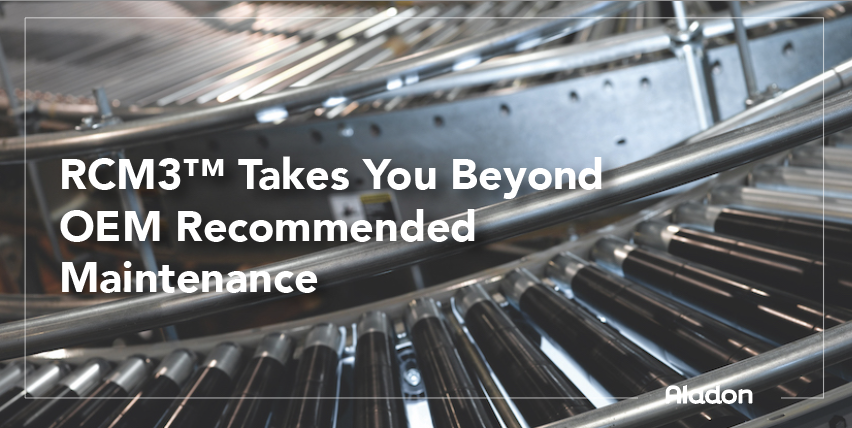Asset managers and maintainers are, by nature, a risk averse bunch of people. And why wouldn’t they be? One poor decision can result in consequences ranging from the merely costly to the fatally disastrous, often with an added layer of spectacularly bad publicity to top it off.
When names like Chernobyl, Deepwater Horizon and Piper Alpha spring to mind, it is perhaps no wonder that many asset managers tend not to stray too far from the Original Equipment Manufacturer’s (OEM’s) recommendations for the development of maintenance regimes. After all, the company that made it should understand the maintenance best.
Why the OEM is not enough
However, absolute adherence to the OEM’s recommendations can have its own pitfalls. An OEM could be pumping out hundreds or even thousands of devices every year. They cannot possibly anticipate the full range of conditions to which customers will subject their products. This means the maintenance recommended by OEMs is often focused on the minimization of failures during the initial warranty period, thus reducing the cost and the risk to the producer.
The maintenance burden is not optimized for a customer that may keep a product in service for upward of 20 years. More importantly, the OEM cannot take into account the operating context of every single customer, which means that a trifling failure for one user could be positively catastrophic for the next. By assuming that the OEM regime will automatically be the safest approach, a product user could blindly accept a high risk of wider system failure effects without even realizing it.
Take the hypothetical example of a simple water pump design, which is delivered to two different users. One customer uses the pump for a reticulation system for a fountain. The other customer uses it for a fire suppression system. The consequences of failure of these otherwise identical pumps are vastly different, yet the recommended maintenance from the OEM is the same regardless. We understand instinctively that this makes no sense, yet it is a situation that is routinely played out over countless organizations.
RCM3™ empowers users to take control of their own maintenance, taking full advantage of in-house knowledge of plant processes and combining it with a robust methodology for the determination of maintenance actions and intervals.
3 benefits of the application of RCM3 to OEMs:
1. Customized maintenance: RCM3 gives managers the ability to take into account their own particular operating context and to understand how each failure mode matters to them.
2. Capitalize on a company workforce: RCM3 allows organizations to capitalize on the accumulated knowledge among its own workforce. Many companies will have operations and maintenance personnel with decades of intimate experience with their equipment. This is experience that most OEMs would not have access to. Unless the OEM also provides maintenance services, their visibility of product performance in the field may be limited to data on returns and repairs under warranty.
3. Retain workforce knowledge: Normally, in-house knowledge is lost to a company when highly skilled individuals retire or move on to seek other opportunities. An RCM3 analysis will establish a deposit of plant information that can be used to inform other personnel, provide a fault finding guide when failures do occur and be a living document that’s updated as plant modifications are made.
Does this mean that advice from the OEM is completely redundant? Quite the opposite. OEMs understand their products from a different point of view, a point of view that is equally important to understanding how a product might behave or fail in a given set of circumstances. A wise manager will seek OEM representation in an RCM3 review and combine that knowledge of how a product will fail with the in-house knowledge of the consequences of that failure.
The power of RCM3 is in its ability to provide a forum for this collaboration of asset stakeholders and capture their combined experience in the development of a defensible maintenance regime based on logical principals. Given the opportunity to participate in such a forum, an OEM may also choose to extend their warranty to include products maintained in accordance with RCM3 principles.
So don’t just blindly leave the OEM’s recommended maintenance in place and unchallenged for the next 20 years. The ‘one size fits all’ strategy will cost you in unnecessary or inappropriate maintenance and will lead to lost equipment availability. Learn from your maintenance data. Learn from your people. Learn from your OEMs. Learn to use RCM3 to your advantage and adapt your maintenance to all the sources of information at your disposal within your operating context.
This article is by Adam Armstrong, Aladon Network Member, Manager of Management Consulting, Engineering & Asset Management Advisory, KPMG. Click here to read more about 3 Best Practices for Working with OEMs and Contractors
Aladon provides a suite of risk and reliability-based methodologies supported by world-class software, that has helped organizations globally for more than 30 years to identify the risks and best strategies for building resilience.
